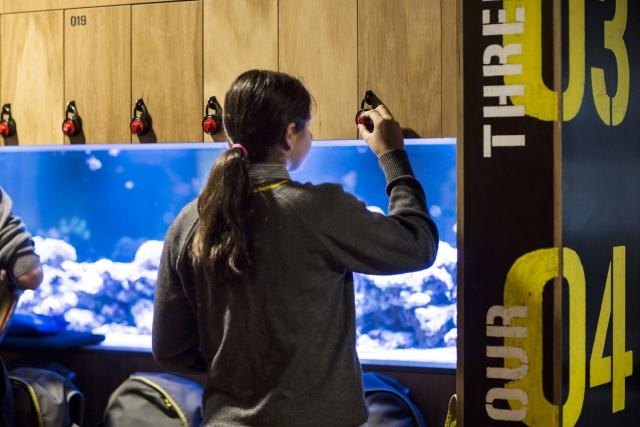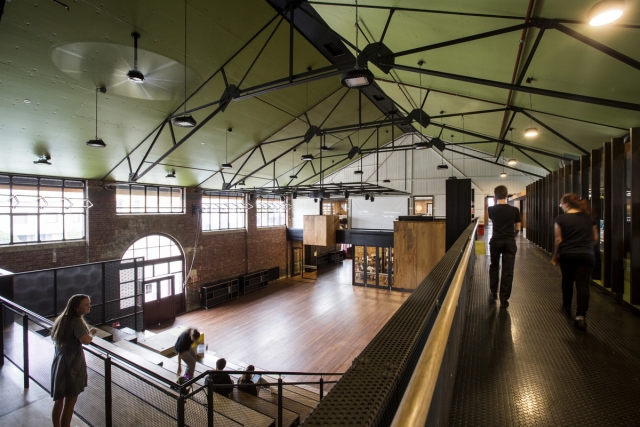Albert Park College is one of Melbourne’s newest and most exciting secondary schools.
It’s modern and progressive, but has important heritage too.
The Albert Park College Environment Arts Hub is an adaptive reuse of a significant heritage listed Sandridge Post and Telegraph Office (JJ Clarke 1887) and Naval Drill Hall (1911).
The Six Degrees Architects’ design highlights the heritage qualities – robust construction, light and airy interiors, and original timber floors … and inserts modern teaching pedagogy and technology.
This multiple award-winning design adapts the existing mezzanine and lower floors into large teaching and learning spaces and retains the Drill Hall as a performance and teaching space.
Connection of the two levels with a stepped timber seating area gives a unique appreciation of the building volume and increases the usefulness of the space for performance and large group activities.
The Post Office is stripped to the original finishes and preserved in an elegantly unfinished state.
Administrative, meeting and music rehearsal spaces are housed in this part of the development, utilizing its cellular brick spaces.
A new link makes wayfinding through the buildings logical and secure, and provides disabled access throughout the buildings.
Key design principles employed were:
- Clear expression of the original heritage building fabric
- Cohesive materiality and subtle form of the inserted new works, using timber finishes to add warmth and texture
- High ESD values.
This widely recognised project contributes in the following ways to Public and Cultural benefit:
- Restoration and adaptive reuse of two significant and Heritage listed structures, the 1897 Sandridge Post and Telegraph Office and the 1911 Naval Drill Hall.
- Removal of hazardous materials from the buildings.
- Contribution to the education and community infrastructure of the Port Melbourne area.
- The large multipurpose space is suitable for a variety of community and exhibition uses, adding to community benefit.
- The kitchen and coffee facility is located to activate the rear laneway.
- High ESD performance and values in the services, using high quality LED lighting and solar boosted hydronic heating.
- Full consideration of access requirements for the partly abled.
Relationship of Built Form to Context: Concepts engaged with new and pre-existing conditions included:
- New external built forms are separated from the heritage structures and are clad in subtle and recessive materials to maintain the relevance of the original layout.
- A new open courtyard is formed using the walls of the later addition to the Post Office, recognizing the adaption of the Post office over time, but also revealing the original layout of the building.
- The main student entrance is relocated to the rear laneway, in order to increase pedestrian safety and activate the rear lane.
- The new entry, access stair and lift are located at the rear of the building to minimize visual impact on the original structures from the main streets.
The planning of the building reflects the functional and pedagogical goals of the school. Planning is rational and stacked to maximize natural wayfinding:
- Existing ground and mezzanine spaces are used for 4 large multipurpose and science classrooms.
- The main Naval Drill Hall space is retained as a multipurpose teaching, meeting and performance space, a function not easily reconciled with the standard DEECD brief and budget controls, but a clear direction of the school’s pedagogical goals for a more mature teaching style.
- The thermal performance of the spaces has been enhanced with exposed insulation as a pedagogical approach to building fabric and enhanced with hydronic heating, again not easily reconciled with DEECD standards.
- Internal finishes are generally timber and plywood for long life and greater warmth and appearance value.
- It should be noted that the School supported many of the design quality upgrades over DEECD standards with their own funds.
The following specialist installations were undertaken with the financial commitment of Albert Park College:
- Low energy LED lighting
- Solar boosted hot water
- Enabled for future Solar photovoltaic power generation.
- Hydronic heating throughout.
- High specification wireless communications to assist in new teaching methods
Sustainability
The building is not rated on any systems but uses a common sense approach to sustainability. The following aspects were significant ESD upgrades in the project
- Increased thermal envelope performance using foilboard ceiling linings.
- Evacuated tube Solar boosted gas fired hydronic heating.
- Evacuated tube Solar boosted hot water.
- Rainwater storage for landscaping and toilets.
- Enabled for future Solar photovoltaic power generation
- Night purge system through operable toplight windows and roof vent dampers.
Response to Client and User needs
The additional benefits of the Building to the community and the school generally are
- Adaptive reuse of two significant heritage buildings
- Provision of a large multipurpose community space for events, performance and exhibition uses
- Addition to the educational infrastructure of Albert Park
- Demonstration project with high ESD values
- An emphasis on people in the design process, both teaching staff and students, with the goal for the design to support a great education experience for all.
It should be noted that Albert Park College provided significant support to the quality of the project outcomes through its self-funding of many aspects of the project to increase particularly the ESD and finishes for long term benefit.
Project Details
Project size – 1,800 m2
Completion date – 2016
Building levels – 2
Project Team
Architecture
Six Degrees Architects
Established in 1992, Six Degrees is one of Australia’s leading architectural practices.
Practice areas include residential, master-planning and place making, aged care and community, office and workplace, hotels and hospitality, and education, delivering design solutions for both new and heritage places.
Project Architect – Mark McQuilton
Documentation – Josie White / Mark McQuilten
Interior Design – Emma Serraglio
Consultant Team
Services – BCS
Building Surveyor – Hendry Group
Structural Engineering – George Apted and Associates
Access – Morris Access Consulting
Heritage – Michael Taylor Architects
Acoustic – Acoustic Consulting Australia
Quantity Surveyor – Simon Wragg & Associates
Construction Team
Builder – McCorkell Constructions
Photography – Simon James
Awards
2017 VSBA Victorian School Design Award, Projects $1m-$5m
2017 AIA (National) The Lachlan Macquarie Award for Heritage
2017 AIA (National) Educational Architecture Award
2017 AIA (Victoria) The Henry Bastow Award for Educational Architecture
2017 AIA (Victoria) The John George Knight Award for Heritage
Photo Gallery
Click on a thumbnail image to enlarge.
Design © 2020 Six Degrees Architects. All Rights Reserved.| Images © 2020 Simon James. All Rights Reserved.
Other Education Projects
Monash University- Caulfield Campus, VCA Elisabeth Murdoch Building, Deakin Waurn Ponds Campus
Get the Builtworks Letter
In every edition of the Builtworks Letter, you’ll get the behind-the-scenes backstory as to how buildings are designed, built, and brought to life.
You’ll hear compelling stories, learn surprising ideas, meet engaging characters, and discover unique voices.























